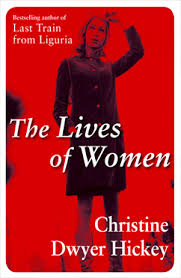Allen and Unwin/Atlantic Books, RRP $27.99
May 2015
 Some books have language that submerges the reader into their world from the first sentence. The Lives of Women by Christine Dwyer Hickey was one such book for me. One moment I was cracking open the cover for the first time wondering what was to come, the next I was ensnared in the world of our narrator Elaine.
Some books have language that submerges the reader into their world from the first sentence. The Lives of Women by Christine Dwyer Hickey was one such book for me. One moment I was cracking open the cover for the first time wondering what was to come, the next I was ensnared in the world of our narrator Elaine.
As an adult Elaine has returned to care for her invalid father in her childhood home, a place where her teenage life remains a ghostly overlay. The landscape of family and the family home are clearly spaces which Elaine has been detached from—both emotionally and physically—for many years and it is time to unravel the cause of this detachment. The adult Elaine’s narrative is interspersed with snippets of her younger life as a teenager coming of age in a suburban estate during the 1970s and her life as an adult in New York and Paris. The different threads of Elaine’s life slowly reveal the tragedy which occurred during her last summer living with her parents.
Family relationships—especially the relationships of mothers and daughters—are writ large across Elaine’s remembrances of her past. In some ways The Lives of Women made me think of the film The Virgin Suicides—albeit a version narrated internally rather than externally. For though this novel is about women they are in many cases without agency, or only slowly gaining agency, in a world that belongs to the shadowy figures of the men in their lives. Thus there is a great deal of suffering in silence, a dogged acceptance of the hand fate has dealt them—with or without the aide of a bottle—an almost collective grief lurking between the shiny façade of the suburbs.* And it is absorbing reading.
The language of The Lives of Women silkily carries the reader through the novel dropping hints to Elaine’s past trauma in passages of the mundane and the everyday. One particular passage where Elaine takes her father’s elderly dog for a long ramble through the night was a particular stand out for me. Within this passage the reader has no thought of what is to come next, there is just the language pulling the reader into this night-lit ramble with this woman and that dog. As the reader emerges from that scene, those pages, there is a sudden and melancholy recognition that the elderly dogs days of rambling are over and that Elaine’s refuge of distance from this physical space of childhood has come to the end and she must remember.
I thoroughly enjoyed The Lives of Women. Deftly plotted, it has the perfect build of tension picking up and running into the ending. An ending where there is closure and explanation to a point, then the reader is left to mull over the ending and make of it what they will.
*One: Have I ever mentioned how much suburbia creeps me out—I’m farm raised and inner-city urban by choice and suburbia is like an alien landscape to my eyes. Two: I totally acknowledge that suffering in silence is not just a 70s thing.

